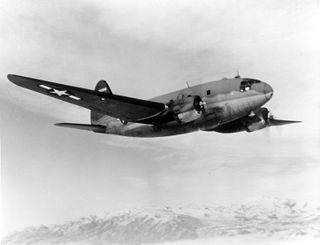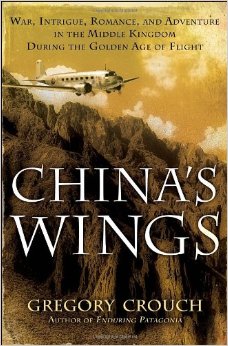Related Research Articles

Pan American World Airways, originally founded as Pan American Airways and commonly known as Pan Am, was an American airline that was the principal and largest international air carrier and unofficial overseas flag carrier of the United States for much of the 20th century. It was the first airline to fly worldwide and pioneered numerous innovations of the modern airline industry, such as jumbo jets and computerized reservation systems. Until its dissolution on December 4, 1991, Pan Am "epitomized the luxury and glamour of intercontinental travel", and it remains a cultural icon of the 20th century, identified by its blue globe logo, the use of the word "Clipper" in its aircraft names and call signs, and the white uniform caps of its pilots.
The Curtiss-Wright Corporation is a manufacturer and services provider headquartered in Davidson, North Carolina, with factories and operations in and outside the United States. Created in 1929 from the consolidation of Curtiss, Wright, and various supplier companies, the company was immediately the country's largest aviation firm and built more than 142,000 aircraft engines for the U.S. military during World War II. Today, it no longer makes aircraft but makes many related components, particularly actuators, aircraft controls, valves, and surface-treatment services. It also supplies the commercial, industrial, defense, and energy markets; it makes parts for commercial and naval nuclear power systems, industrial vehicles, and oil- and gas-related machinery.

Juan Terry Trippe was an American commercial aviation pioneer, entrepreneur and the founder of Pan American World Airways, one of the iconic airlines of the 20th century. He was involved in the introduction of the Sikorsky S-42, which opened trans-Pacific airline travel, the Boeing 307 Stratoliner which introduced cabin pressurization to airline operations, the Boeing 707 which started a new era in low cost jet transportation, and the Boeing 747 jumbo jets. Trippe's signing of the 747 contract coincided with the 50th anniversary of Boeing. He also founded InterContinental Hotels & Resorts.

Fairbanks International Airport is a state-owned public-use airport located three miles (5 km) southwest of the central business district of Fairbanks, a city in the Fairbanks North Star Borough of the United States state of Alaska. It is located in the South Van Horn census-designated place. Fairbanks was the smallest city in the United States with regularly scheduled non-stop international flights, as Condor offered weekly flights to Frankfurt during the summer tourist season. Air North is now the only international airline to offer scheduled charters with flights.

The Curtiss C-46 Commando is a low-wing, twin-engine aircraft derived from the Curtiss CW-20 pressurised high-altitude airliner design. Early press reports used the name "Condor III" but the Commando name was in use by early 1942 in company publicity. It was used primarily as a cargo aircraft during World War II, with fold-down seating for military transport and some use in delivering paratroops. Mainly deployed by the United States Army Air Forces, it also served the U.S. Navy/Marine Corps, which called it R5C. The C-46 filled similar roles as its Douglas-built counterpart, the C-47 Skytrain, with some 3,200 C-46s produced to approximately 10,200 C-47s.

The China National Aviation Corporation was a Chinese airline which was nationalized after the Chinese Communist Party took control in 1949, and merged into the People's Aviation Company of China (中國人民航空公司) in 1952. It was a major airline under the Nationalist government of China.

The Hump was the name given by Allied pilots in the Second World War to the eastern end of the Himalayan Mountains over which they flew military transport aircraft from India to China to resupply the Chinese war effort of Chiang Kai-shek and the units of the United States Army Air Forces (USAAF) based in China. Creating an airlift presented the USAAF a considerable challenge in 1942: it had no units trained or equipped for moving cargo, and no airfields existed in the China Burma India Theater (CBI) for basing the large number of transports that would be needed. Flying over the Himalayas was extremely dangerous and made more difficult by a lack of reliable charts, an absence of radio navigation aids, and a dearth of information about the weather.
The Bermuda Agreement, reached in 1946 by American and British negotiators in Bermuda, was an early bilateral air transport agreement regulating civil air transport. It established a precedent for the signing of approximately 3,000 other such agreements between countries. The Agreement was replaced by the Bermuda II Agreement, which was signed in 1977 and effective in 1978.
Suparna Airlines, known in Chinese as Jinpeng, is an airline based in China. It was formerly known as Yangtze River Express and later Yangtze River Airlines after launching passenger services. The company's headquarters are in Shanghai Pudong Development Bank Tower in Pudong, Shanghai.

The Consolidated Commodore was an American flying boat built by Consolidated Aircraft and used for passenger travel in the 1930s, mostly in the Caribbean, operated by companies like Pan American Airways.

George Conrad Westervelt was a U.S. Navy engineer who created the company "Pacific Aero Products Co." together with William Boeing. Westervelt left the company in 1916 and Boeing changed the name of the company to the Boeing Airplane Company the following year.

William Douglas Pawley was a U.S. ambassador and noted businessman who was associated with the Flying Tigers American Volunteer Group (AVG) during World War II.

As of December 2017, there are 229 commercial airports in China.

Shanghai Longhua Airport (上海龙华机场), then called Shanghai Lunghwa Airport, was a converted general aviation airport and PLAAF airfield located south of downtown Shanghai, China, on the bank of the Huangpu River. It opened in the early 1920s and served as the city's airport until the 1950s when Shanghai Hongqiao International Airport opened. Thereafter, it was one of two general aviation airports serving Shanghai and also served as an emergency landing site for police, fire and rescue operations southwest of the city. The airport was eventually closed at 1966, and the airport grounds were slowly built over though a period of between 1993 and 2016.
Roy Clinton Farrell was the American co-founder of Cathay Pacific Airways along with the Australian Sydney de Kantzow.
Curtiss-Caproni was an Italian-American aircraft manufacturer formed in the late 1920s to produce Caproni aircraft in America as part of the Curtiss-Wright aviation conglomerate.

The Kweilin incident occurred on 24 August 1938 when a Douglas DC-2 airliner named Kweilin carrying 18 passengers and crew was shot down by Japanese aircraft in China. There were fourteen fatalities. It was the first civilian airliner in history to be shot down by hostile aircraft. The pilot was American and the crew and passengers Chinese. As it was unprecedented for a civilian aircraft to be attacked, there was international diplomatic outrage over the incident. In the United States, it helped solidify the view that Japan was morally wrong in their war against China, however the incident was not enough to spur the US into action against Japan despite Chinese entreaties. The Kweilin was rebuilt, renamed as the Chungking and destroyed by the Japanese army in a second attack two years later.

China's Wings: War, Intrigue, Romance and Adventure in the Middle Kingdom during the Golden Age of Flight is a 2012 book by Gregory Crouch, published by Bantam Books. The book discusses the history of the China National Aviation Corporation (CNAC) and is focused on William Langhorne Bond as the central character. Harry Eagar of the Maui News stated that "is largely a biography of Bond." The book also describes Moon Fun Chin, a Chinese-American who rose from peasant roots, to become a lead CNAC pilot and finally to owning his own airline. Among other events, the book discusses the establishment of the first airline in China, the Second Sino-Japanese War, "The Hump" airlift, and the 1938 Kweilin incident. The book ends after the 1949 Communist takeover.

China National Aviation Holding Corporation Limited, also known as Air China Group, is a Chinese state-owned enterprise which is the parent company of Air China and Air Macau. The company was formed on 11 October 2002 by the merger of Air China, China Southwest Airlines, and China National Aviation Corporation (Group) Limited.

Rebecca Chan Chung was an American military nurse who served with the Flying Tigers and the United States Army in China during World War II. As a nurse with the China National Aviation Corporation (CNAC), she flew over The Hump approximately fifty times. After the war, she became a nursing educator and a leader of the nursing profession in Hong Kong.
References
- ↑ John D. Plating The Hump: America's Strategy for Keeping China in World War II,Texas A&M University Press, 2011 ISBN 1603442375 pp. 35-37